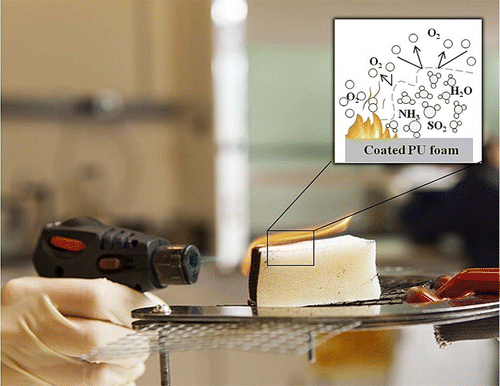Safer, more environmentally friendly flame retardant with first-of-its-kind dual effects

Amid concerns over the potential health effects of existing flame retardants for home furniture, fabrics and other material, scientists are reporting development of an "exceptionally" effective new retardant that appears safer and more environmentally friendly. Their report on the first-of-its-kind coating, ideal for the polyurethane foam in couches and bedding that causes many fire deaths, appears in ACS Macro Letters.
Jaime Grunlan and colleagues explain that upholstery furniture and mattresses are the items that ignite in about 17,000 fires each year, causing more than 870 deaths, thousands of injuries and millions of dollars in property loss. Since the polyurethane foam in these items is highly flammable, consumer protection agencies have issued stringent safety standards to reduce flammability. But health and environmental concerns exist over some of the traditional flame retardants that manufacturers add to meet those standards. Grunlan's team thus set out to develop safer, more environmentally benign flame retardants.
They describe successful development and laboratory testing of a new flame retardant coating for polyurethane foam. The "nanocoating" is so thin that 1,000 layers of it would fit across the width of a human hair, and it is made with a relatively benign polymer that creates a "gas blanket," preventing oxygen from fueling a fire. It is the first flame retardant that both reduces the heat released from fire and prevents the foam from dripping and spreading flames to the rest of the room or house. "The heat release reductions are significant and likely would slow fire growth in real world fire scenarios, giving people more time to escape or to put out the foam, thus, preventing flashover events," the report says.
More information:
"Exceptionally Flame Retardant Sulfur-Based Mutilayer Nanocoating for Polyurethane Prepared from Aqueous Polyelectrolyte Solutions" ACS Macro Lett., 2013, 2, pp 361–365
DOI: 10.1021/mz400105e
Abstract
Many current flame retardant (FR) strategies for polymers contain environmentally harmful compounds and/or negatively impact processing and mechanical properties. In an effort to overcome these issues, a effective flame retardant nanocoating comprised of positively charged chitosan (CH) and anionic poly(vinyl sulfonic acid sodium salt) (PVS) was deposited onto flexible polyurethane foam using layer-by-layer (LbL) assembly. This coating system completely stops foam melt dripping upon exposure to the direct flame from a butane torch. Furthermore, 10 CH-PVS bilayers (30 nm thick) add only 5.5% to the foam's weight and completely stop flame propagating on the foam due to the fuel dilution effect from non flammable gases (e.g, water, sulfur oxides, and ammonia) released from the coating during degradation. Cone calorimetry reveals that this same coated foam has a 52% reduction in peak heat release rate relative to an uncoated control. This water-based, environmentally benign nanocoating provides an effective postprocess flame retardant treatment for a variety of complex substrates (foam, fabric, etc.).
Provided by American Chemical Society


















